Dakhla Far Back and Beyond
We stayed in Dakhla in the Canadian Dig House. There was a moment of utter confusion where the checkpoint police were saying "Canadian? American? Hollander??" and our driver was insisting "No, three Australians". The penny dropped and he admitted that we were staying in the Canadian house.
The house is marvelous. Barry, architect trained and working on reconstruction, had drawn it on a piece of paper, and given it to the cook, who arranged to have it built. This could only really happen in Egypt. It easily sleeps about forty people - and maybe more.
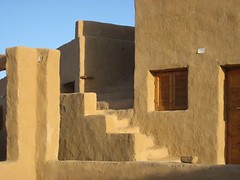
It is entirely mud brick and timber with the exception of the shower area which has concrete beneath a mud cladding. Perhaps the fear of sodden mud brick collapsing on naked wet archaeologists was more than they could risk. This is an entrancing building. It curves and undulates and is gentle on the eyes at all times of day. A flat roof area is surrounded by bench seating, and ideal for evening drinks at beer o'clock. The toilets are long drops, and doors kept tightly shut to reduce flies and smell. They brought back dashes to outback dunnies in Australia in my childhood, with torn up sheets of newspaper on a clip and attempting to hold my breathe for as long as possible. I never worked out if it was better to breathe lightly and shallowly from the beginning or risk that long deep intake when the air ran out!
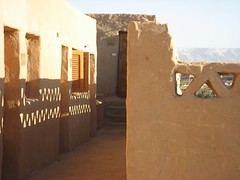
A long path runs past the sleeping areas on the upper level, and from here you look out across the oasis. There are the constant date palms, and vegetables below and wheat and fodder crops - green ending abruptly in desert. It is surprisingly flat considering we are in a big depression - it is as if the earth just dripped in a huge disc, leaving the rest sitting up above and wondering where it got to.
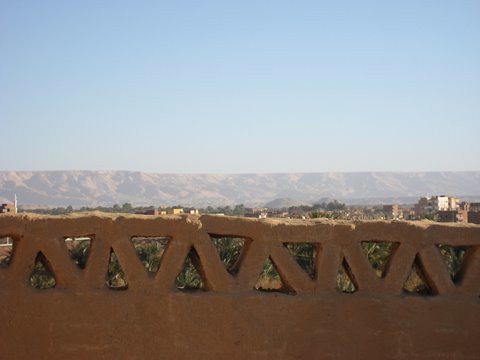
On the first day we arrived and ate lunch - delicious with a thick spiced potato and onion soup and fresh salads, bread baked that morning on the premises and a thick and tarry homemade marmalade which has left such a lingering memory that I think I will have to make some. The bread is wonderful. While I like the aish balady - the flatbread - of most of Egypt, it was a joy to bite into thick moist slices of this - it was like an Italian loaf on first sight, but with the softer crust, yellowish and elastic texture inside and so delicious.
We looked at the workrooms and ate dinner with the archaeologists and headed for bed. They had coffins there which had had plaster laid directly onto bandaging, and this was covered in paintwork. No photos as I do not know how much had been published and how much hasn't.
Next morning we climbed into a bus. After a previous experience where a bus had arrived as an empty shell with no seats, this time Colin had organised one with seats. Funny the things you take for granted.
First stop was a dig with an early temple which was completely submerged in clay. Worse, it was the kind of mud that swelled when wet and as it moved through the village that used to be here, swelling, then contracting, it had moved, lifted and destroyed almost everything there. The temple was huge and built with stone, but every stone was broken into many pieces by this alternating compression and release. While embedded it was fine, but excavation meant removing the clay, now set to the strength of concrete, and as the clay was removed the stone risked crumbling away completely. The archaeologist in charge described the process. Dig a trench, shoring up stone and reconstructing as you go. Then draw and record as fast as possible, Then backfill, and dig the next narrow trench. It sounded appalling and painstaking and it was sad to see the grandeur that it must have had, and the way it has been damaged by regular flooding.
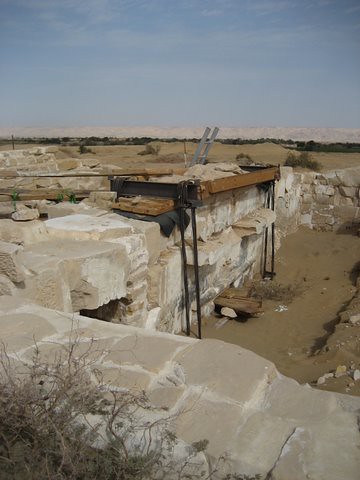

above - Bob with the yellow bag and a lot of the young archaeologists from Monash. We are standing at roof level of the old temple.
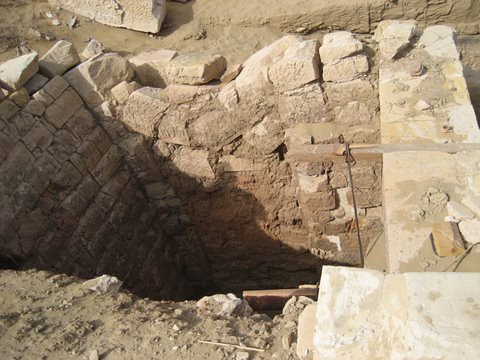
Note the distortion at the upper levels and the way the whole wall swings out on the right side.
From here we drove through a local village where the team used to live. I loved this. There is an old Roman tomb inside and it is really beautiful and serene. Local archaeologists have excavated part of it to below floor level to show the coffins lined up which would have been under the floor.
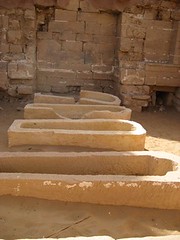
The village here is all mud brick - and yes, in the most colonial way I do like my villages picturesque. There is something about the juxtapositions of honeyed walls and desert and scrappy scrub and long vistas that I find deeply appealing.
So - just have a look at a spread of photos without too much comment. I have to point out the little lass in tiger stripes though as the outfit was utterly incongruous.

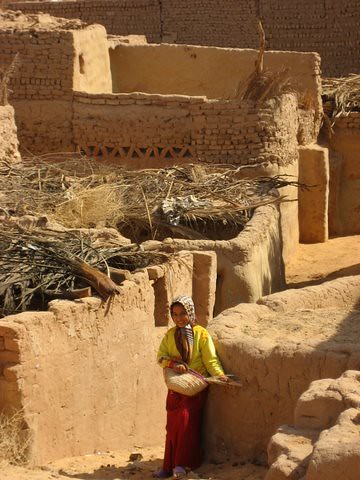
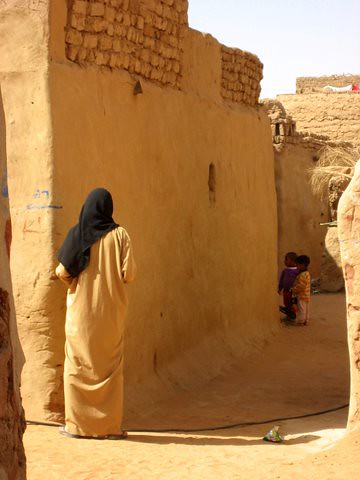

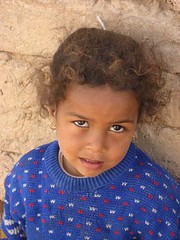


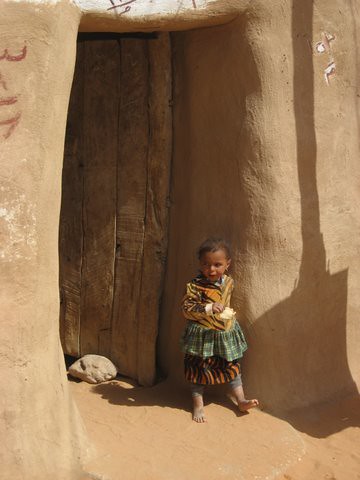
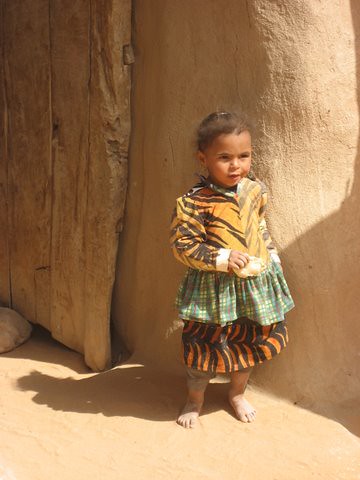


For today that is your ration. Those who like photos should be happy. tomorrow - more of the digs and that is fun too!
The house is marvelous. Barry, architect trained and working on reconstruction, had drawn it on a piece of paper, and given it to the cook, who arranged to have it built. This could only really happen in Egypt. It easily sleeps about forty people - and maybe more.

It is entirely mud brick and timber with the exception of the shower area which has concrete beneath a mud cladding. Perhaps the fear of sodden mud brick collapsing on naked wet archaeologists was more than they could risk. This is an entrancing building. It curves and undulates and is gentle on the eyes at all times of day. A flat roof area is surrounded by bench seating, and ideal for evening drinks at beer o'clock. The toilets are long drops, and doors kept tightly shut to reduce flies and smell. They brought back dashes to outback dunnies in Australia in my childhood, with torn up sheets of newspaper on a clip and attempting to hold my breathe for as long as possible. I never worked out if it was better to breathe lightly and shallowly from the beginning or risk that long deep intake when the air ran out!

A long path runs past the sleeping areas on the upper level, and from here you look out across the oasis. There are the constant date palms, and vegetables below and wheat and fodder crops - green ending abruptly in desert. It is surprisingly flat considering we are in a big depression - it is as if the earth just dripped in a huge disc, leaving the rest sitting up above and wondering where it got to.

On the first day we arrived and ate lunch - delicious with a thick spiced potato and onion soup and fresh salads, bread baked that morning on the premises and a thick and tarry homemade marmalade which has left such a lingering memory that I think I will have to make some. The bread is wonderful. While I like the aish balady - the flatbread - of most of Egypt, it was a joy to bite into thick moist slices of this - it was like an Italian loaf on first sight, but with the softer crust, yellowish and elastic texture inside and so delicious.
We looked at the workrooms and ate dinner with the archaeologists and headed for bed. They had coffins there which had had plaster laid directly onto bandaging, and this was covered in paintwork. No photos as I do not know how much had been published and how much hasn't.
Next morning we climbed into a bus. After a previous experience where a bus had arrived as an empty shell with no seats, this time Colin had organised one with seats. Funny the things you take for granted.
First stop was a dig with an early temple which was completely submerged in clay. Worse, it was the kind of mud that swelled when wet and as it moved through the village that used to be here, swelling, then contracting, it had moved, lifted and destroyed almost everything there. The temple was huge and built with stone, but every stone was broken into many pieces by this alternating compression and release. While embedded it was fine, but excavation meant removing the clay, now set to the strength of concrete, and as the clay was removed the stone risked crumbling away completely. The archaeologist in charge described the process. Dig a trench, shoring up stone and reconstructing as you go. Then draw and record as fast as possible, Then backfill, and dig the next narrow trench. It sounded appalling and painstaking and it was sad to see the grandeur that it must have had, and the way it has been damaged by regular flooding.


above - Bob with the yellow bag and a lot of the young archaeologists from Monash. We are standing at roof level of the old temple.

Note the distortion at the upper levels and the way the whole wall swings out on the right side.
From here we drove through a local village where the team used to live. I loved this. There is an old Roman tomb inside and it is really beautiful and serene. Local archaeologists have excavated part of it to below floor level to show the coffins lined up which would have been under the floor.

The village here is all mud brick - and yes, in the most colonial way I do like my villages picturesque. There is something about the juxtapositions of honeyed walls and desert and scrappy scrub and long vistas that I find deeply appealing.
So - just have a look at a spread of photos without too much comment. I have to point out the little lass in tiger stripes though as the outfit was utterly incongruous.











For today that is your ration. Those who like photos should be happy. tomorrow - more of the digs and that is fun too!


7 Comments:
Oh WOW Jenny, what an experience and thanks for all the wonderful photos, cheers Pennie
2 fabulous entries and wonderful photos. Thank you, Jenny.
Love, Tena
Thanks for your so interesting blog. I really miss you when you are having a break from it. DH and I spent 3 weeks on a trip Nov 2005 Cairo to Aswan and back to Alexandria.Could do it again so amazing. Don't expect to read any more on my blog have given up trying to use my password etc ........Natalie
Hi Mum! Sounds fantastic (of course!). Loved the photos - they reminded me of Bahariah (sp?). Look forward to seeing you again.
Lots of love,
Karmen
Your posts are wonderful, Jenny, it gives the reader the sensation that I am tagging along with you on your adventures. Thanks.
Thank you for the guided tour. Just beautiful.
Wonderful, wonderful images Jenny, and I love the descriptions to go with them. I could never fall asleep on your blog, too busy living vicariously through you!
Post a Comment
<< Home